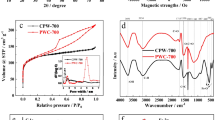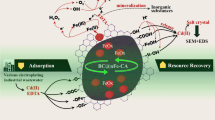Abstract
Biochar-based Fe–Ce bimetallic Fenton-like heterogeneous catalyst was prepared and applied to the degradation of wastewater produced during the synthesis of caprolactam (wastewater-CPL) in the presence of micro-nano bubbles (MNB). The prepared materials were characterized by X-ray diffraction (XRD), Fourier transform infrared (FT-IR) spectroscopy, field emission scanning electron microscope (SEM), and X-ray photoelectron spectroscopy (XPS), which confirmed the successful loading of Fe and Ce and the formation of Fe2O3 and CeO2. The treatment effects of different reaction systems were compared, indicating that biochar-based catalyst + H2O2 + MNB system had the best treatment effect that the COD removal rate can reach 93.26%. The influencing factors of the system were discussed, and finally it was concluded that the condition of Fe:Ce was 3:1, hydrogen peroxide concentration was 1.2 M, pH was 2, catalyst dosage was 1 g/L, and temperature was 35 ℃. The treatment effects of adding MNB were compared; the treatment effect of MNB + H2O2 on wastewater was about 60% higher than that of H2O2 alone. The reusability of the catalyst was determined, and it was observed that high catalytic performance could be retained after five cycles. Finally, the water quality of the effluent was analyzed, and it was proved that the treatment of wastewater-CPL had a good effect. This study provided a new idea for the treatment of wastewater-CPL.








Similar content being viewed by others
Data Availability
Applicable.
Code Availability
Not applicable.
References
Ahmed, M. B., Zhou, J. L., Ngo, H. H., Guo, W., Chen, M. (2016). Progress in the preparation and application of modified biochar for improved contaminant removal from water and wastewater. Bioresource Technology, 31–42. https://doi.org/10.21967/jbb.v4i1.180
Agarwal, A., Ng, W. J., Liu, Y. (2011). Principle and applications of microbubble and nanobubble technology for water treatment. Chemosphere, 1175–1180. https://doi.org/10.1016/j.chemosphere.2011.05.054
Bardestani, R., Roy, C., & Kaliaguine, S. (2019). The effect of biochar mild air oxidation on the optimization of lead(II) adsorption from wastewater. Journal of Environmental Management, 404–420. https://doi.org/10.1016/j.jenvman.2019.03.110
Bello, M. M., Raman, A. A. A., & Asghar, A. (2019). A review on approaches for addressing the limitations of Fenton oxidation for recalcitrant wastewater treatment. Process Safety and Environmental Protection, 119–140. https://doi.org/10.1016/j.psep.2019.03.028
Chen, X.-G., & Huang, Z.-P. (2013). Treatment of refractory organic wastewater by advanced Fenton oxidation and iron-carbon micro-electrolysis. Guangdong Chemical, Pages, 249, 252–253. (in Chinese).
Chen, D. X., OuYang, X. K., Wang, Y. G., Yang, L. Y., Wu, K. J., & He, C. H. (2014). Adsorption of caprolactam from aqueous solution by novel polysulfone microcapsules containing [Bmim][PF6].Colloids and Surfaces A: Physicochemical and Engineering Aspects, 72–76. https://doi.org/10.1016/j.colsurfa.2013.08.069
Chen, X.-L., Li, F., Chen, HongYu, Wang, HuiJuan, & Li, GuGong. (2020). Fe2O3/TiO2 functionalized biochar as a heterogeneous catalyst for dyes degradation in water under Fenton processes. Journal of Environmental Chemical Engineering. https://doi.org/10.1016/j.jece.2020.103905
Du, S. (2019). SBR-Electro-catalysis combined process for the treatment of caprolactam waste water test research. Environmental Engineering Technology Journal, 52–56. (in Chinese).
El-Banna, M. F., Mosa, A., Gao, B., Yin, X., Ahmad, Z., & Wang, H. (2018). Sorption of lead ions onto oxidized bagasse-biochar mitigates Pb-induced oxidative stress on hydroponically grown chicory: experimental observations and mechanisms. Chemosphere, 887–898. https://doi.org/10.1016/j.chemosphere.2018.06.052
Fan, W., Zhou, Z., Wang, W., Huo, M., Zhang, L., Zhu, S., Yang, W. & Wang, X. (2019). Environmentally friendly approach for advanced treatment of municipal secondary effluent by integration of micro-nano bubbles and photocatalysis. Journal of Cleaner Production, 117–125.
Furman, O., Laine, D. F., Blumenfeld, A., Teel, A. L., Shimizu, K., Cheng, I. F., & Watts, R. J. (2009). Enhanced reactivity of superoxide in watersolid matrices. Environmental Science and Technology, 43, 1528–1533.
Ghanbari, F., Ahmadi, M., & Gohari, F. (2019). Heterogeneous activation of peroxymonosulfate via nanocomposite CeO2-Fe3O4 for organic pollutants removal: The effect of UV and US irradiation and application for real wastewater. Separation and Purification Technology, 115732. https://doi.org/10.1016/j.seppur.2019.115732
Grosvenor, A. P., et al. (2004). Investigation of multiplet splitting of Fe 2p XPS spectra and bonding in Fe compounds. Surface and Interface Analysis, 1564–1574.
Jae-Hun, C., Jin-Kyu, K., Seong-Jik, P., Chang-Gu, L. (2020). Application of magnetic biochar derived from food waste in heterogeneous sono-Fenton-like process for removal of organic dyes from aqueous solution. Journal of Water Process Engineering, 101455. https://doi.org/10.1016/j.jwpe.2020.101455
Khataee, A., Hassandoost, R., & Pouran, S. R. (2018). Cerium-substituted magnetite: Fabrication, characterization and sonocatalytic activity assessment. Ultrasonics Sonochemistry, 626–640. https://doi.org/10.1016/j.ultsonch.2017.10.028
Li, F., Bo Chen, Yu., Han, Y. C., Hong, X., & Mancai, Xu. (2021). Enhanced adsorption of caprolactam on phenols-modified Amberlite XAD16. Reactive and Functional Polymers, 161, 1–9. https://doi.org/10.1016/j.reactfunctpolym.2021.104850
Li, H., Li, X., Long, J., Li, K., Chen, Y., Jiang, J., Chen, X. & Zhang, P. (2019). Oxidation and removal of thallium and organics from wastewater using a zero-valent-iron-based Fenton-like technique. Journal of Cleaner Production, 89–97. https://doi.org/10.1016/j.jclepro.2019.02.205
Li, X. L. (2018). Experimental study on pretreatment of caprolactam wastewater by iron-carbon micro-electrolysis process. Shanxi Chemical Industry, 198–199. (in Chinese)
Liu, J., Yang, X., Liu, H., Cheng, W., & Bao, Y. (2020). Modification of calcium-rich biochar by loading Si/Mn binary oxide after NaOH activation and its adsorption mechanisms for removal of Cu(II) from aqueous solution. Colloids and Surfaces a: Physicochemical and Engineering Aspects, 124960. https://doi.org/10.1016/j.colsurfa.2020.124960
Nguyen, T. D., Dinh, C. T., & Do, T. O. (2011). Two-phase synthesis of colloidal annular-shaped CexLa1-xCO3OH nanoarchitectures assembled from small particles and their thermal conversion to derived mixed oxides. Inorganic Chemistry, 1309–1320.
Niu, J. L. (2018). Preparation of magnetic biochar catalyst and its catalytic organic synthesis reaction. Master thesis. Hebei Normal University (in Chinese).
Park, J. H., Wang, J. J., Xiao, R., Tafti, N., DeLaune, R. D., & Seo, D. C. (2018). Degradation of Orange G by Fenton-like reaction with Fe-impregnated biochar catalyst. Bioresource Technology, 368–376. https://doi.org/10.1016/j.biortech.2017.10.030
Roes, A. L., Patel, M. K. (2011). Ex-ante environmental assessments of novel technologies-Improved caprolactam catalysis and hydrogen storage. Journal of Cleaner Production, 1659–1667. https://doi.org/10.1016/j.jclepro.2011.05.010
Roy, K., & Moholkar, V. S. (2020). Sulfadiazine degradation using hybrid AOP of heterogeneous Fenton/persulfate system coupled with hydrodynamic cavitation. Chemical Engineering Journal, 121294. https://doi.org/10.1016/j.cej.2019.03.170
Rubeena, K. K., Reddy, P. H. P., Laiju, A. R., & Nidheesh, P. V. (2018). Iron impregnated biochars as heterogeneous Fenton catalyst for the degradation of acid red 1 dye. Journal of Environmental Management, 320–328. https://doi.org/10.1016/j.jenvman.2018.08.055
Rueda-Márquez, J. J., Sillanpää, M., Pocostales, P., Acevedo, A., & Manzano, M. A. (2015). Post-treatment of biologically treated wastewater containing organic contaminants using a sequence of H2O2 based advanced oxidation processes: Photolysis and catalytic wet oxidation. Water Research, 85–96. https://doi.org/10.1016/j.watres.2014.12.054
Shuang, Xu., Li, J., Yin, Z., Liu, S., Bian, S., & Zhang, Y. (2020). A highly efficient strategy for enhancing the adsorptive and magnetic capabilities of biochar using Fenton oxidation. Bioresource Technology., 315, 123797. https://doi.org/10.1016/j.biortech.2020.123797
Suliman, W., Harsh, J. B., Abu-Lail, N. I., Fortuna, A. M., Dallmeyer, I., & Garcia-Perez, M. (2016). Modification of biochar surface by air oxidation: Role of pyrolysis temperature. Biomass and Bioenergy, 85.
Sun, T. et al. (2019). Efficient degradation of p-arsanilic acid with released arsenic removal by magnetic CeO2-Fe3O4 nanoparticles through photo-oxidation and adsorption. Journal of Alloys and Compounds, 151689. https://doi.org/10.1016/j.jallcom.2019.151689
Sun, R., Zhang, X., Wang, C., & Cao, Y. (2021). Co-carbonization of red mud and waste sawdust for functional application as Fenton catalyst: Evaluation of catalytic activity and mechanism. Journal of Environmental Chemical Engineering, 105368. https://doi.org/10.1016/j.jece.2021.105368
Wang, L., Ali, J., Wang, Z., Oladoja, N. A., Cheng, R., Zhang, C., Mailhot, G. & Pan, G. (2020). Oxygen nanobubbles enhanced photodegradation of oxytetracycline under visible light: Synergistic effect and mechanism. Chemical Engineering Journal, 124227. https://doi.org/10.1016/j.cej.2020.124227
Xia, Q. X. (2019). Preparation and degradation of phenol by Fenton catalyst based on iron. Master thesis. Harbin Institute of Technology (in Chinese).
Xu, L. L. (2015). Preparation of carbon nanocomposites and their catalytic degradation of organic pollutants. Master thesis, Zhejiang university. (in Chinese).
Xu, L., & Wang, J. (2012). Magnetic nanoscaled Fe3O4/CeO2 composite as an efficient Fenton-like heterogeneous catalyst for degradation of 4-chlorophenol. Environmental Science & Technology, 10145–10153.
Yamashita, T., & Hayes, P. (2008). Analysis of XPS spectra of Fe2+ and Fe3+ ions in oxide materials. Applied Surface Science, 2441–2449. https://doi.org/10.1016/j.apsusc.2007.09.063
Yujian, J., Na, L., Haiqiu, L., Xia, H., Qiuying, Z., Chen, M., & Teng, F. (2014). Highly efficient degradation of dye pollutants by Ce-doped MoO3 catalyst at room temperature. Dalton Transactions, 43, 12860–12870.
Zhao, T., Yao, Y., Li, D., Wu, F., Zhang, C., & Gao, B. (2018). Facile low-temperature one-step synthesis of pomelo peel biochar under air atmosphere and its adsorption behaviors for Ag(I) and Pb(II). Science of the Total Environment, 73–79.
Zong, B., Sun, B., Cheng, S., Mu, X., Yang, K., Zhao, J., Zhang, X., Wu, W. (2017). Green Production Technology of the Monomer of Nylon-6: Caprolactam. Engineering, 379–384. https://doi.org/10.1016/J.ENG.2017.03.003
Zou, F. C., Ren, W., Peng, F. (2014). Application of catalytic ozonation in the advanced treatment of caprolactam wastew.
Funding
The study was financially supported by the National key Research and development program of China (2018YFE0106400); Key Research and Development Program of Hebei Province (20373604D); Key Projects of Anhui Provincial Department of Education (KJ2020A0051); Projects of Key Laboratory of Bio-organic Fertilizer Creation, Ministry of Agriculture and Rural Affairs, P. R. China (BOFA202007); and Training Program for Innovative Research Team in Tianjin Institutions of Higher Education (TD13-5021).
Author information
Authors and Affiliations
Corresponding author
Ethics declarations
Ethics Approval
Not applicable.
Consent to Participate
Applicable.
Consent for Publication
Applicable.
Conflicts Interests
The authors declare no competing interests.
Additional information
Publisher's Note
Springer Nature remains neutral with regard to jurisdictional claims in published maps and institutional affiliations.
Rights and permissions
About this article
Cite this article
Zhang, R., Wang, J., Yang, J. et al. Treatment of Wastewater-CPL by Biochar-Based Fenton-Like Catalyst in the Presence of Micro-nano Bubbles. Water Air Soil Pollut 233, 207 (2022). https://doi.org/10.1007/s11270-022-05654-1
Received:
Accepted:
Published:
DOI: https://doi.org/10.1007/s11270-022-05654-1




